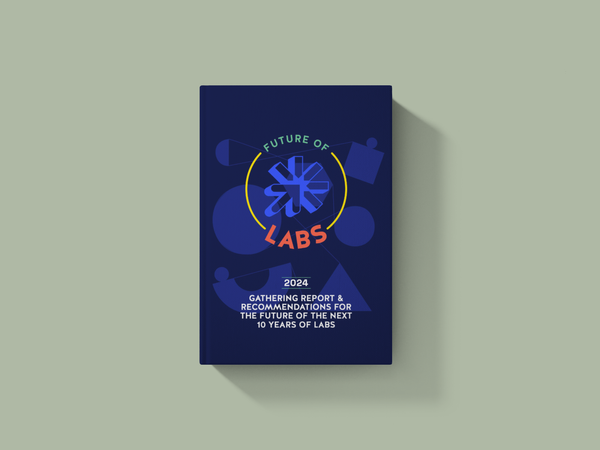The Future of Labs - Part 2: Reflections
As our understanding of complex challenges advances and there is global exploration of the ways of seeing, being, doing which enable us to respond effectively - is there still a role for the Lab in the landscape of change approaches?
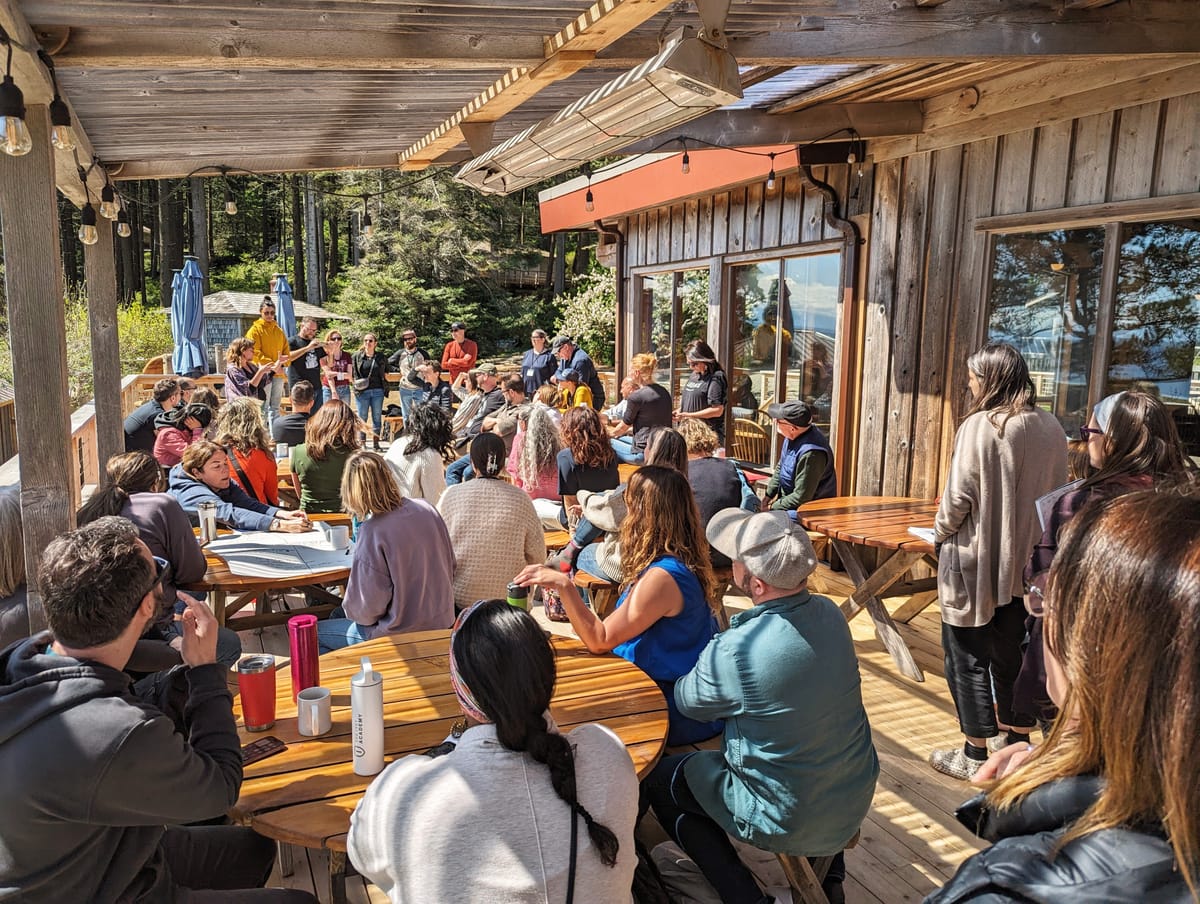
The arc of labs focused on complex challenges over the past 15 years or so has been an interesting one. Social Labs are typically a fusion practice drawn from facilitation, action research, innovation management, participatory design, indigenous relational approaches and more. Labs accelerated most rapidly between 2010-2019, before the pandemic curbed the growth and hampered the relational and collaborative practices they utilised.
After some experienced Lab practitioners in Canada at Action Lab noticed there seemed to be a lull in activity and some shifts in the field, they put out a call to see whether others were noticing the same and keen to gather to talk about the future of Labs. There was an overwhelmingly positive response, and the Future of Labs Gathering was born - with the team landing on Cortes Island, BC and Hollyhock Retreat Centre as the location.


60 Lab Practitioners. 3 Days. 1 Gathering.
Fast forward to May 2024 and experienced lab practitioners, consultants, funders and field builders came from across the world to (re)connect, explore, debate, shape and invest in the vital deep relational work a field of practice like this needs. We came from the Basque Country, Barcelona, Serbia, all across Canada, and yours truly from Australia.
I wrote in my last post about the questions which framed our time together:
- Conversation 1: Defining Labs
- Conversation 2: Exploring our 'niche', situating Labs amongst other change approaches
- Conversation 3: What's reasonable to expect from Labs?
- Conversation 4: Helpful Lab practices
- Conversation 5: What are the necessary conditions and supporting ecosystem for social innovation labs to thrive in Canada?
The Gathering was opened by local indigenous elders from the Klahoose First Nation, with story, song calling in our ancestors and a warm welcoming spirit. The work we set ourselves was not just a cold, rational, cognitive exploration of the questions, but also the deeper work of building relationship, trust, reciprocity, and understanding. We began in a circle, and we spent much of our time in circle work - large or small.
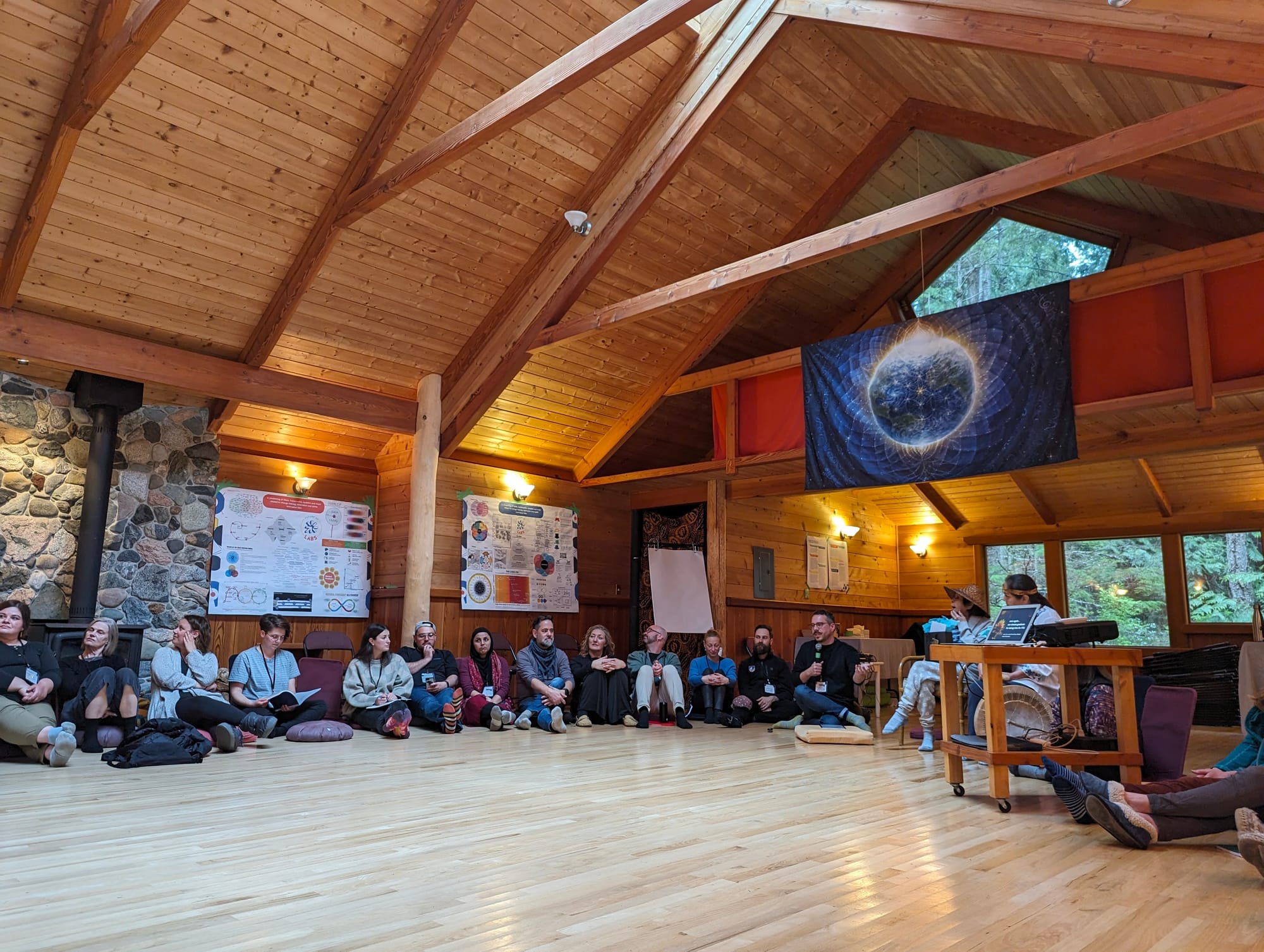
There will be significant outputs from the Gathering focused on what was explored, named and decided upon - a report, a podcast, maybe more. I won't aim to spend the rest of this post focused on trying to sum up the experience as I simply couldn’t due to so many parallel streams of conversation.
Instead I feel some rough reflections on personal themes and questions I am holding as I transition back to Australia, might be suitable.
Social Innovation Labs x Living Labs
I have spent a considerable chunk of my last 10 years devoted to social (innovation) labs, and this gathering was primarily focused on that model. Yet my current work is largely framed around living labs, and so I spent many conversations trying to tease apart if there are differences, and if so - what they are, whether they matter, and what one could learn from the other.
Where I have landed is that:
- Social Innovation Labs are a practice which emerged (and continues to evolve) focused around bridging different perspectives and agendas to tackle complex challenges more systemically. In doing so they have become strong in relational practices to address power, equity and shift the possibilities of the system, as well as exploring and prototyping new initiatives and recognising the broad types of value labs can generate via the likes of developmental evaluation.
- Living Labs emerged from an academic and industry framing focused on better implementation of new initiatives, and have accelerated in Europe especially (but certainly not limited to) sustainability transitions and health. They have strengths in structuring and supporting collaboration, place-based work, data & evidence documentation, prototyping & scaling and learning systems around these lab ecosystems. They have been well positioned in Europe to receive significant funding, tapping into the European Research & Innovation agenda such as Horizon Fund.
What might be possible if we blend the best of both approaches to accelerate the work to address complex challenges around the world?
What other models are in this confluence of change approaches, which might also be part of a ‘future of labs’ practice?
Ecosystem of approaches to change
As we spoke, it was also clear that the landscape of change work is also advancing in different ways around the world. Less so in Canada, but in Europe and Australia (and perhaps other regions), there is increasing recognition of the likes of Mission (or Challenge) oriented Innovation - perhaps best articulated in proximate practice by Designing Missions (Vinnova / Dan Hill) and Challenge-led Innovation guide from Griffith University in Australia, and perhaps Monash University’s new publication on Mission-oriented Research.
In addition to these, we listed a number of other approaches which we see as part of the ecosystem, including:
- Collective Impact
- Place-based approaches (such as community development)
- Open innovation challenges
- Citizen assemblies
- iTeams
- and more
We recognise Labs are often an ecotone (the coming together of multiple ecosystems) and need to connect with other initiatives and approaches for different stages and maturities of initiatives, as well as understanding who else to engage with at different times, to make them more effective and impactful.
How might we better understand and best engage with the ecosystems of change work around Labs?
International bridging
I hosted an open space session on the final day on bridging and weaving work for International practice and practitioners, which attracted an amazing group of people who shared a slew of reasons we believe this is important. Not only did we see real value across the Gathering from the exchange between the Canadian and International contingent, but the different cultures, values and local practices were rich and generative.
Recognising that working in the world of complex challenges and labs can be busy and intense - we know that relying on a few people to do this through their employment or as extra-curricular meetups (often at crazy times of the day and night depending which continent is hosting), is not a suitable strategy for sustaining bridging work. So what other options should we explore? Research networks? Fellowships? A global organisation? Something else?
What models might best support the evolution of Lab practice and nurture practitioner relationships around the world?
New types of impact measures
As always, there was much debate about the breadth and depth of the outcomes and impacts of Labs, what could be reasonably expected, and how to communicate these to funders, participants and other stakeholders.
Whilst various projects have looked at new approaches to describe the outcomes of Labs, such as Mark Cabaj’s work around developmental evaluation, most significant change and the likes - we realise there can still be a disconnect between what funders and supporters are looking for, and how Labs communicate their outcomes.
To that end across the Gathering, and in a huddle after an event hosted by SI Canada and SFU Radius, we explored some themes:
- Language - is the language of Benefits & co-benefits more useful than Outcomes and Impact?
- Common models - Relational work, collaboration, co-creation of prototypes, scaling initiatives (deep, out, up, etc)
- Recognising different types of outputs - for example the 6 Capitals?
- Conversion and simplicity - the potential for converting some of the evaluation findings into financial valuations - for example, what is the financial value of growing social capital between people in a group? Other worlds (such as management consultants) do this, and whilst it can be problematic, it could be one tool to try to explore the value created by labs?
- Proxies for Future Outcomes - how to capture the potential of the relational work, the trust, the priming to enable deep collaboration which will result in better outcomes? If we take examples from other fields - for example, in some sports they are increasingly using statistical methods to capture where a game is going - such as xG in soccer - the likely goals scored by a player or team. Could we somehow measure the potential of a group to develop new collaborative initiatives? xCI?
How can we bridge the language and expectation gap between dominant tales of ‘reliable outcomes’ and the reality of ‘emergent outcomes’ and invent novel modes to evaluate and tell stories of effective Lab practice?
Expanding and experimenting with the toolkit
Whilst we recognised the need not to make Labs “about everything” during the gathering, I spent some time with new friends during one of the evenings imagining a world without Labs - instead we invented a reality tv series to explore themes of depolarisation and reconciliation.
Whilst it was a bit (alright a lot) of fun, the underlying themes it surfaced was that sometimes we can be overly earnest and lose sight of alternative ways to attract people to and sustain the work over time. The likes of adrienne maree brown’s “Pleasure Activism”, Bill McKibben’s “Radio Free Vermont” and Wright & Neimand’s “The Secret to Better Storytelling for Social Change”, Ruhar Benjamin’s “Imagination: a manifesto” all explore themes of joy, pleasure, humour, imagination and entertainment in the pursuit of social change work.
Perhaps this means we need deeper relationships with artists, entertainers and media-savvy friends who can create new expressions for the work, and also vary the methods and approaches we use inside our Labs?
This is absolutely not the limit of how I imagine expanding the toolkit. I think there’s plenty of opportunity to explore angles of building ‘systems sight’ and ‘identifying and advancing responses’ in the lab process through integrating research and knowledge translation, through the likes of data visualisation, poetry, biomimicry, augmented reality, open civic data hubs, visual arts, documenting and scaling starting conditions, carving, open source social franchises, and a range of other methods and approaches.
If we reimagined lab practice as an integration of the most promising tools, methods and structures to support how we address complex challenges, what would be in our kete aronui?
Lab Model
Finally, riffing on conversations about the core of lab practice, theories of change, and beyond, I started thinking about how to visually represent a common model of how Labs take shape. It’s a draft, and I welcome feedback:
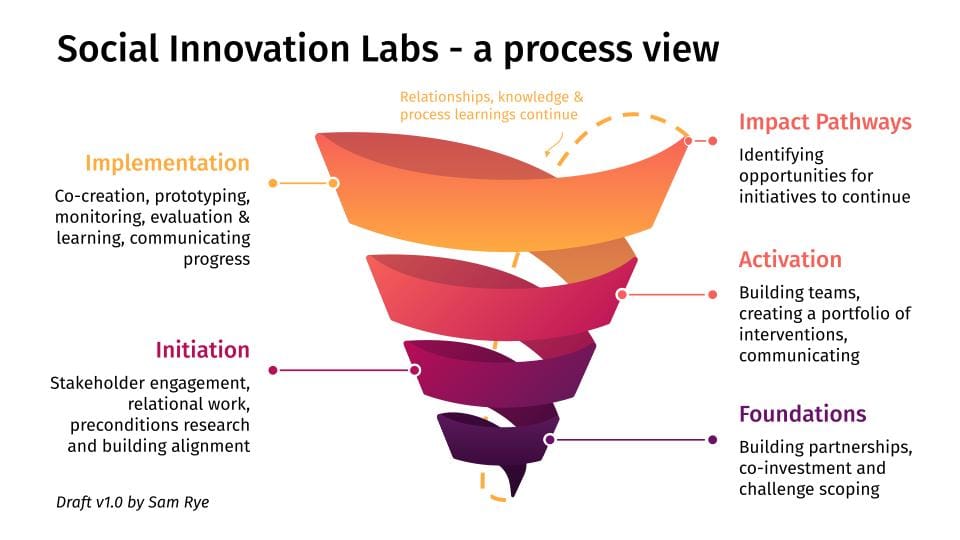
Wrapping up
The time in Canada was inspiring and felt like an important deepening of connection with practitioners aligned in values, approach, as well as with a country which has many similarities to Australia & Aotearoa New Zealand. We have much to continue to explore together, and I look forward to establishing a sustained connection and investing in the fostering of the global lab community.
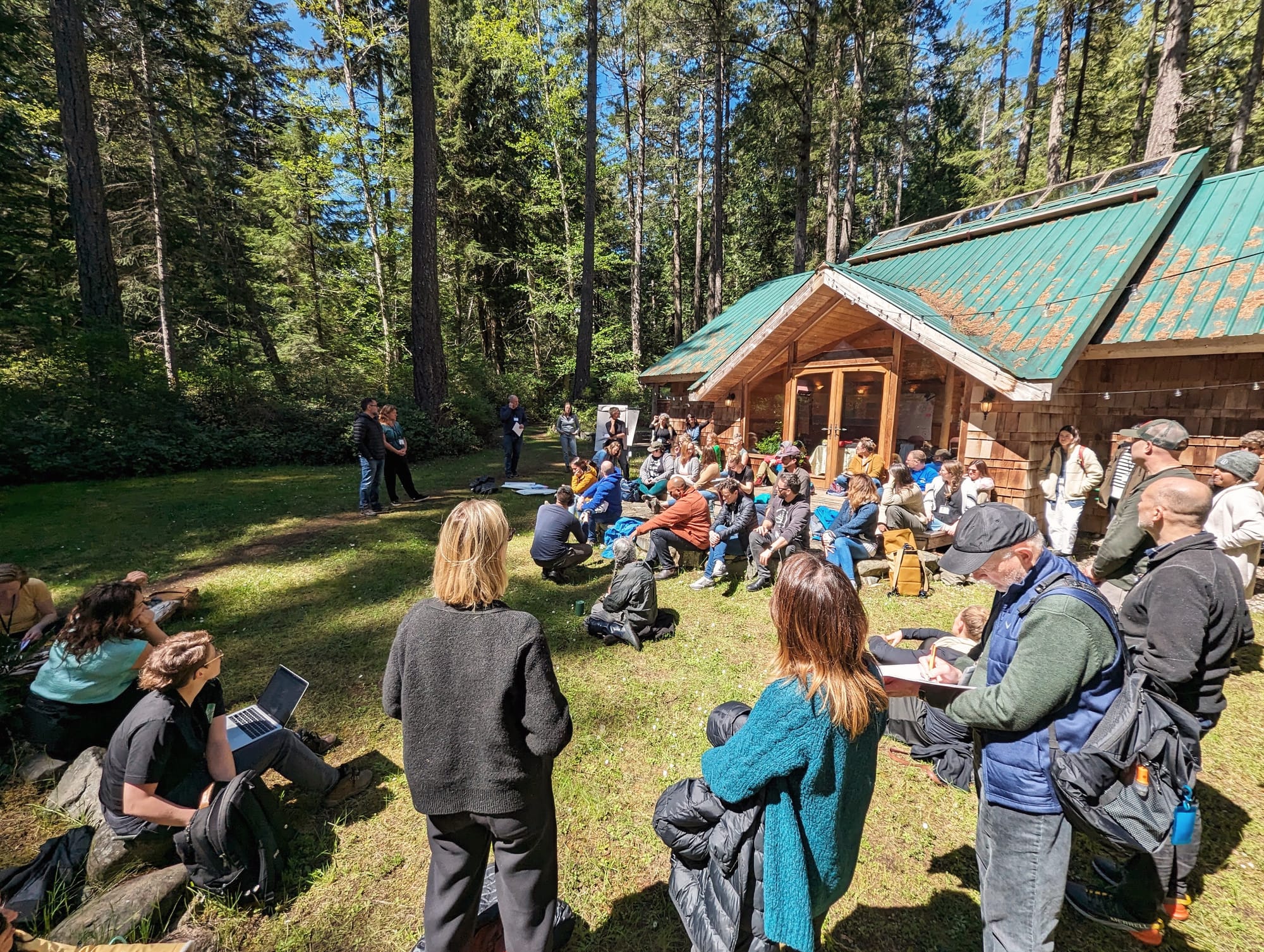
As we closed the circle, tied the tobacco, there was a reflection that "the future of labs is relational". Deep down, I believe we need more Lab practice, more ambition, and more practitioners if we are to tackle the degree of complex challenges which grow in scale and risk every year.
"The future of Labs is relational"
Onwards, in whanaungatanga.
🌱





